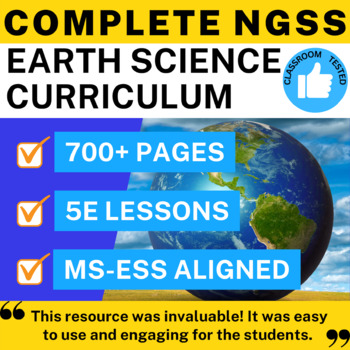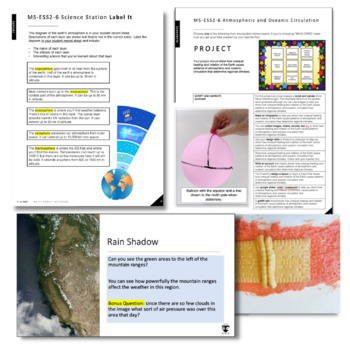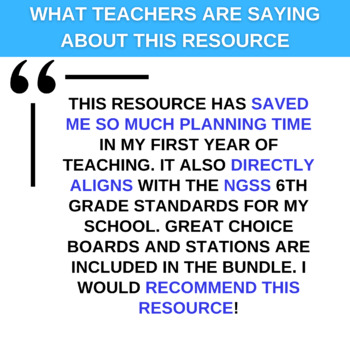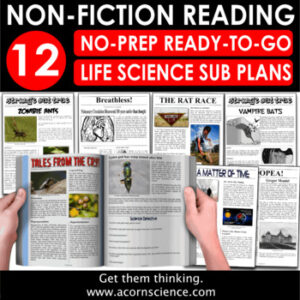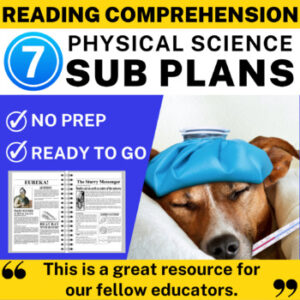Description
“This resource has saved me so much planning time in my first year of teaching”. Save 100s of hours planning lessons with these 5E Earth Science lessons. Your students will love learning about Earth Science with these engaging lessons. Easy to follow and fun to use and teach. This bundle covers the entire NGSS Middle School Earth Science curriculum. It is packed with resources specially designed to align with the NGSS standards.
A plug ‘n play google classroom distance learning version is also included for every resource so you’re all set whether you have face to face classes or have to teach remotely. You can relax and teach knowing that you’ve got this covered.
“This resource was invaluable as I was teaching the content for the first time! It was easy to use and engaging for the students”. Victoria W.
“Thank you for this amazing bundle of resources! It is helping me get ready for distance learning with my class.” Maggie Weis.
“Amazing resource! Thank you so much for the work you have provided to help”. Allissa A K.
Complete 5E lessons with powerpoints, notes, and labs all compliment each other to save you time and make your life a whole lot easier. Your Earth Science curriculum is covered. You can relax and teach.
Topics Covered
MS-ESS1-1 Earth Sun Moon System
“Develop and use a model of the earth-sun-moon system to describe the cyclic patterns of lunar phases, eclipses of the sun and moon, and seasons“.
- Moon Phases
- Earth’s tilt and seasons
- Solar Eclipses
- Lunar Eclipses
MS-ESS1-2 Gravity, Solar System, Galaxies
“Develop and use a model to describe the role of gravity in the motions within galaxies and the solar system“.
- The Solar System
- Gravity
- The Milky Way and other galaxies
- Gravity depends on mass and distance
- Formation of the Solar System
- Black Holes
MS-ESS1-3 Scale and Properties of the Solar System
“Students will analyze and interpret data to determine scale properties of objects in the solar system”.
- Calculate It – The students are given data on the planets and must calculate this in order to compare it to Earth.
- Graph It – the students are given data on the planets which they then graph.
- Read It – the students read about the famous Rosetta mission to land on a comet and answer questions on the text in the record sheet.
- Infer It – students are shown a sheet showing pictures of the planets. The questions on the sheet will ask them to make inferences from these pictures/descriptions.
- Identify It – This station has two pages, one describing various solar system objects and the second page showing images of solar system objects. Students must identify the objects from the description and from the images.
- Write It – Students read and summarize the advances in solar system science made possible by improved engineering and advances in science.
MS-ESS1-4 Earth’s History and the Geologic Timescale
“Show how the geologic time scale is used to organize Earth’s 4.6 billion year old history based on evidence from rock strata“.
- Stratigraphy
- Law of Superposition
- Law of Original Horizontality
- Relative and Absolute Dating
- The Fossil Record
- Radiometric Dating
MS-ESS2-1 The Rock Cycle
“Develop a model to describe the cycling of Earth’s materials and the flow of energy that drives this process“.
- Igneous Rocks
- Sedimentary Rocks
- Metamorphic Rocks
- Weathering
- Erosion
- Deposition
- Intrusive and Extrusive
- Crystallization
- Compaction
- Cementation
MS-ESS-2-2 Plate Tectonics
Construct an explanation based on evidence for how geoscience processes have changed Earth’s surface at varying time and spatial scales.
- Alfred Wegener’s Theory of Continental Drift and Pangea
- Evidence: fossil, rock layers, sea floor spreading, GPS
- Convection Currents
- Converging plates
- Diverging plates
- Subduction
- Sea ridge
- Fault-block mountains
- Fold mountains
- Volcanic mountains
- Seismic waves; P waves, S waves
- Richter scale
- Weathering – mechanical/chemical
- Erosion
- Deposition
The Case for Continental Drift NGSS MS-ESS2-3
“Analyze and interpret data on the distribution of fossils and rocks, continental shapes, and seafloor structures to provide evidence of the past plate motions”.
Lawyer up and prepare your defense ! Poor old Alfred Wegener is in the dock accused of bringing the scientific community into disrepute with his wild theory of continental drift. Time to bring in the expert witnesses. Your students are going to examine the evidence and prepare his defense.
This will be a lesson to remember. Each science station is arranged as a court exhibit. At each station the students will examine the evidence and note how this helps their client’s case in their defense notes.
The Water Cycle MS-ESS2-4
“Develop a model to describe the cycling of water through Earth’s systems driven by energy from the sun and the force of gravity”.
- Evaporation
- Evapotranspiration
- Condensation
- Precipitation
- Runoff
- Aquifer
- The role of gravity and the sun
The Weather Complete 5E MS-ESS2-5 lesson
“Collect data to provide evidence for how the motions and complex interactions of air masses result in changes in weather conditions.”
- Atmospheric Air Pressure
- Temperature
- Humidity
- Dew Point
- Air Masses
- Weather Maps
- Weather Fronts
- Cold Fronts
- Warm Fronts
- Occluded Fronts
- Stationary Fronts
- Collecting data
- Forecasting
Uneven Distribution of Resources MS-ESS3-1 Complete 5E lesson
“Construct a scientific explanation based on evidence for how the uneven distributions of Earth’s mineral, energy, and groundwater resources are the result of past and current geoscience processes”.
- Uneven distribution of coal, copper, groundwater, natural and shale gas
- That the uneven distributions of the Earth’s mineral, energy, and groundwater resources are the results of past and current geologic processes.
- Type and distribution of a: mineral, energy, and groundwater.
- Evidence for the past and current geologic processes (e.g., volcanic activity, sedimentary processes) that have resulted in the formation of each of the given resources.
- The ways in which the extraction of each type of resource by humans changes how much and where more of that resource can be found.
Natural Hazards MS-ESS3-2 Complete 5E lesson
“Analyze and interpret data on natural hazards to forecast future catastrophic events and inform the development of technologies to mitigate their effects.”
- What is a natural hazard
- Types of natural hazard
- Predicting a natural hazard
- Understanding the natural hazards in a region and their cause
- Human and economic cost of natural hazards
Minimize Human Impact on the Environment MS-ESS3-3 Compete 5E Lesson
“Apply scientific principles to design a method for monitoring and minimizing a human impact on the environment”.
- Deforestation
- The Downside of Dams
- Diverting Rivers
- Land Desertification
- Air Pollution
Human Impact on the Environment MS-ESS3-4 Complete 5E Lesson
“Construct an argument supported by evidence for how increases in human population and per-capita consumption of natural resources impact Earth’s systems”.
The powerpoint is the same as MS-ESS3-3 as both these these standards are so intertwined.
- Tech It – Students will view an interactive map on a human impact on the environment and answer questions.
- Graph It – students will create a graph from a set of data allowing them to compare the effects of human population increase with an environmental impact.
- Read It – here the students read about the impact of plastic pollution.
- Label It – students will create an infographic based on the provided text and data.
- Explain It – students are shown photos of human impacts on the environment and they are asked to explain these.
- Analyze It – students are given information on how positive changes at a global level have made an impact on the environment. The questions on the station sheet will ask them to analyze these diagrams.
Human Impact on Global Temperatures MS-ESS3-5 Science Stations
“Ask questions to clarify evidence of the factors that have caused the rise in global temperatures over the past century”.
Lawyer up and prepare your defense! Global warming is in the dock. Time to bring in the expert witnesses. Your students are going to examine the evidence that it is human activity that has caused global warming and prepare a defense. This will be a lesson to remember. Each science station is arranged as a court exhibit. At each station the students will examine the evidence and note how this helps their client’s case in their defense notes.
NGSS and Next Generation Science Standards are a registered trademark of Achieve. Neither Achieve nor the lead states and partners that developed the Next Generation Science Standards was involved in the production of, and does not endorse, this product.

